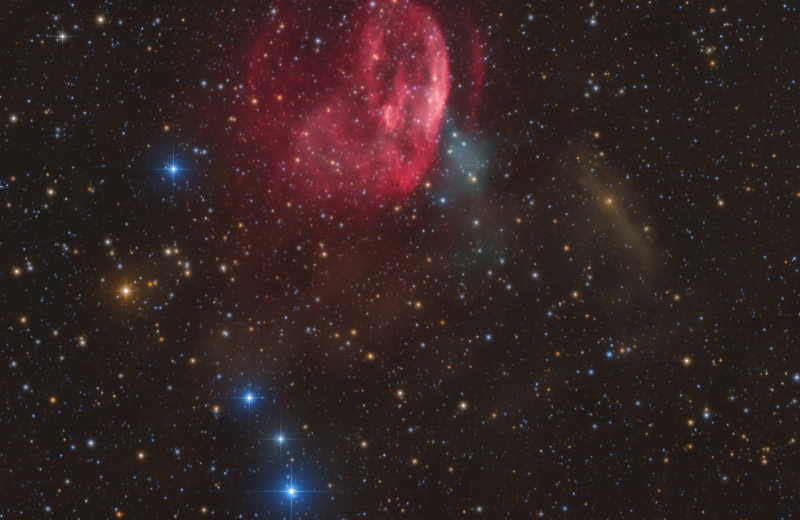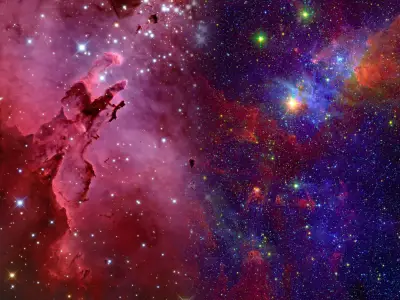The Triangulum Australe constellation is a fascinating triangular constellation in the southern sky. If you’ve ever wondered about the stars and the stories that accompany them, this provides an understanding of the Triangulum Australe constellation and its key features.
Jump to:
- What is the Triangulum Australe Constellation?
- What Does Triangulum Australe Look Like?
- How Far is the Triangulum Australe Constellation from Earth?
- The Triangulum Australe Constellation Myth
- Triangulum Australe's Stars
- Nebulae in the Triangulum Australe Constellation
- Finding Triangulum Australe in the Sky
- Fun Facts About Triangulum Australe
- Study Astronomy for £29
Recommended for you!
Best SellersWhat is the Triangulum Australe Constellation?
Triangulum Australe is a small but distinct constellation located in the southern hemisphere. Its name comes from the Latin for “southern triangle,” a fitting description of its triangular shape formed by three bright stars. Unlike its northern counterpart, the Triangulum constellation, which lies close to the Andromeda Galaxy, Triangulum Australe shines in a different part of the sky, close to the constellations of Norma and Ara.
What Does Triangulum Australe Look Like?

Despite its relatively small size, Triangulum Australe is easy to spot due to its bright and clearly defined triangular pattern. It consists of three bright stars: Alpha, Beta, and Gamma Trianguli Australis. These stars are positioned to form a nearly perfect equilateral triangle, which is why it’s known as the “southern triangle constellation.”
How Far is the Triangulum Australe Constellation from Earth?
If you’re curious about the distance of this triangular constellation from Earth, the answer lies in the individual stars that form it. The brightest, Alpha Trianguli Australis, is approximately 391 light-years away. Beta and Gamma Trianguli Australis are similarly distant, though slightly closer than Alpha. To put it into perspective, when you look at Triangulum Australe, you are essentially seeing light that has travelled hundreds of years to reach your eyes!
The Triangulum Australe Constellation Myth

Unlike many other constellations that are steeped in ancient mythology, the Triangulum Australe constellation doesn’t have a rich mythological story tied to it. Its name, however, gives a nod to its northern counterpart, the Triangulum constellation, which is linked to Greek mythology and the goddess Ceres. Instead, Triangulum Australe is more a product of modern celestial mapping, with its simplicity and geometric shape making it a useful marker in the southern hemisphere.
Although it lacks a mythological background, Triangulum Australe’s triangle shape has often been seen as a symbol of stability and strength, mirroring the qualities of the shape itself. For navigators and explorers, this constellation provided a fixed point in the sky, helping to guide their voyages.
Triangulum Australe's Stars
The three main stars of Triangulum Australe make it stand out among the southern constellations.
- Alpha Trianguli Australis: The brightest star in the constellation, Alpha shines with a magnitude of 1.91. It is a giant star, several times larger than the Sun, and it’s this brightness that makes it the easiest to spot.
- Beta Trianguli Australis: The second-brightest star, Beta Trianguli Australis, has a magnitude of 2.85. It contributes to the formation of the triangle and is slightly less bright than Alpha.
- Gamma Trianguli Australis: The final point of the triangle, Gamma, has a magnitude of 2.87. While it may not be as bright as Alpha, it completes the geometric perfection of this constellation.
Nebulae in the Triangulum Australe Constellation

While the constellation itself doesn’t boast any major nebulae like some other star groups, it lies close to the famous Coalsack Nebula, a large dark nebula in the Milky Way. The Coalsack Nebula can be seen near the Southern Cross constellation, not far from Triangulum Australe. For stargazers, this provides an extra point of interest when observing the area around Triangulum Australe.
Finding Triangulum Australe in the Sky
To catch the best view of Triangulum Australe, plan your stargazing session during the southern winter months, particularly from May to August. During this time, Triangulum Australe is positioned at its highest point in the night sky, making it easier to locate and observe.
Locating Triangulum Australe
Begin by identifying nearby constellations like the Southern Cross (Crux), Norma, and Ara, which are prominent in the southern sky during these months. These constellations serve as useful reference points. The Southern Cross, in particular, stands out due to its brightness and recognisability. Once you've located these constellations, you can navigate to Triangulum Australe, which is nearby and identifiable by its bright triangular star pattern.
For more precise assistance, a star map or stargazing app can help. These tools align with the current sky, guiding you to the three stars that form the clear triangle of Triangulum Australe. This is especially useful if you’re new to stargazing or the stars aren't as bright due to local conditions.
Viewing Triangulum Australe with Binoculars or a Telescope
- With Binoculars: While Triangulum Australe’s stars are relatively bright, binoculars can enhance the clarity of the constellation’s triangular shape, especially in areas with light pollution.
- With a Telescope: A telescope provides an even clearer and more detailed view, allowing you to enjoy the constellation's structure and explore nearby celestial objects. It’s a fantastic tool for zooming in on the individual stars within the constellation.
Best Viewing Conditions
To fully appreciate Triangulum Australe, find a location with minimal light pollution and a dark, clear sky. A moonless night is ideal, as it will enhance the visibility of the constellation’s stars. This gives you the best opportunity to observe Triangulum Australe and its distinct triangular form.
Recommended for you!
Best SellersFun Facts About Triangulum Australe
- Small but Mighty: Triangulum Australe may be a small constellation, but its simple, triangular shape makes it stand out in the southern sky.
- Southern Hemisphere Exclusive: Unlike some constellations that can be seen from both hemispheres, Triangulum Australe is strictly visible from the southern hemisphere.
- Historical Significance: Triangulum Australe was officially recorded by Dutch navigators in the 16th century during their travels to the southern seas.
- Scientific Value: Despite its modest size, the constellation has been used in navigation and astronomy for centuries, helping travellers and scientists alike.
Study Astronomy for £29
If the Triangulum Australe constellation has sparked your curiosity, why not explore more about the stars and the cosmos with our Astronomy Diploma Course at Centre of Excellence? This course offers you a detailed understanding of the universe, from constellations and star types to the fundamentals of space observation. Perfect for all budding astronomers, the course is available for a discounted price of £29.













